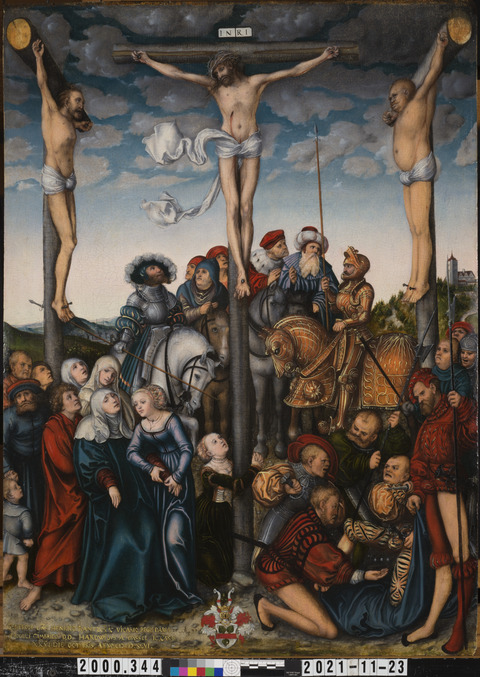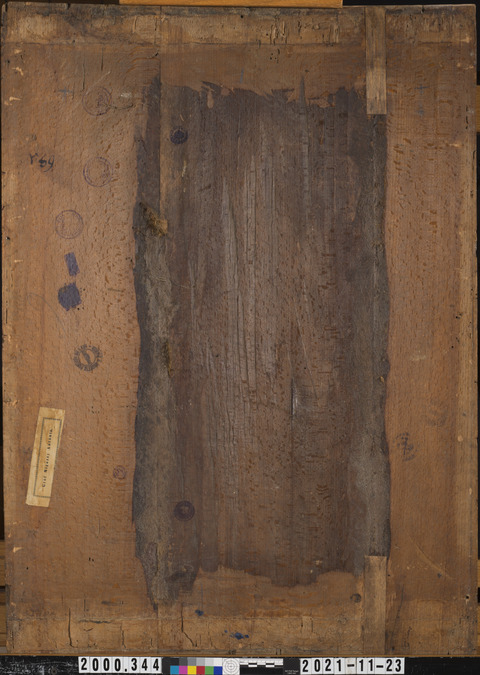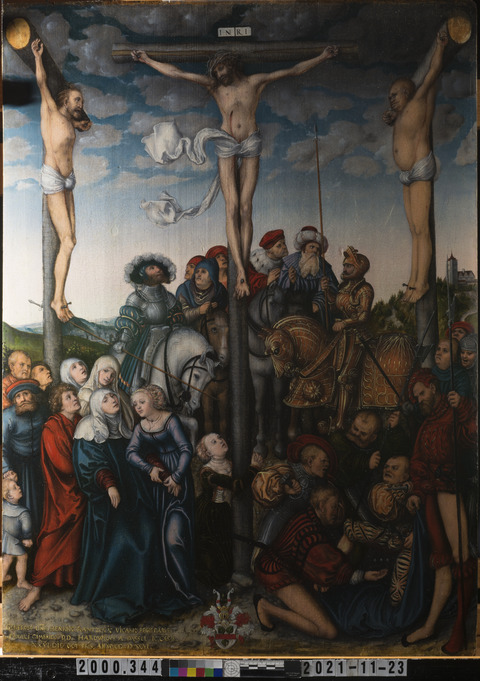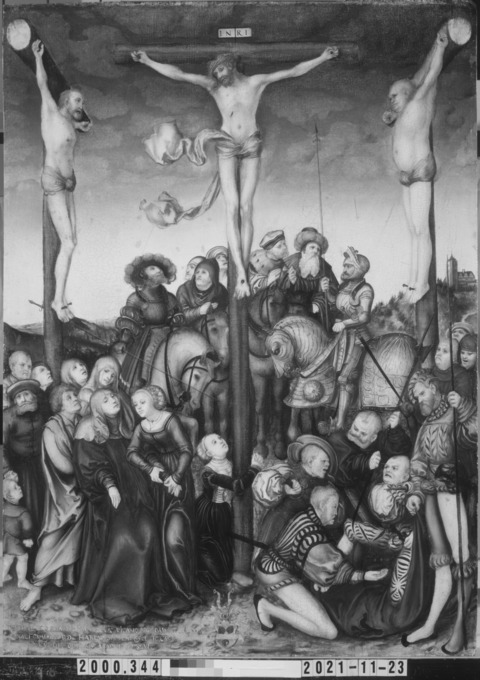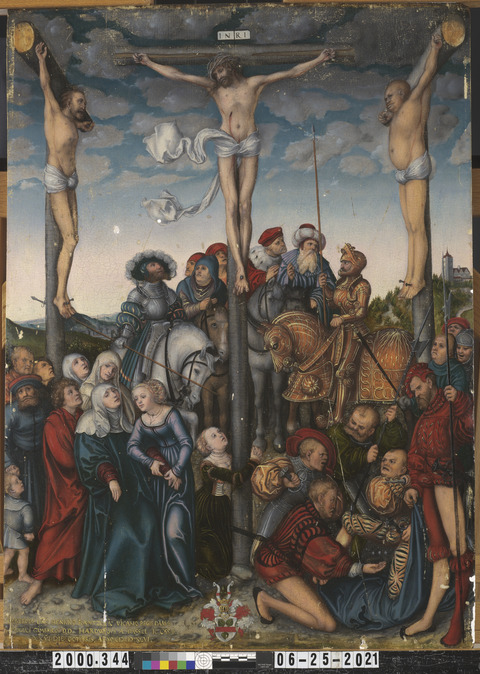Overview
Accession number: 2000.344
Artist: Lucas Cranach the Elder
Title: Crucifixion
Materials: Oil (untested) on beech panel
Date of creation: 1532
Previous number/accession number: C10030
Dimensions: 75.8 × 55 cm
Conservator/examiner: Roxane Sperber
Examination completed: 2021
Distinguishing Marks
Front:
Item 1. Inscription painted in yellow paint, lower-left corner, “GENEROSO DNO HENRICO RANTZOVIO VICARIO REGIS DANIÆ/ PRODUCI CIMBRICO D.D. HARDWIGUS A DASSEL IC. CÆSAR./XXVI DEI OCTOBRIS. ANNO. CD.D.XCVI” (tech. fig. 1)

Item 2. Inscription painted in brown paint, lower edge, “15 [Cranach’s coat-of-arms signature] 32” (tech. fig. 2)
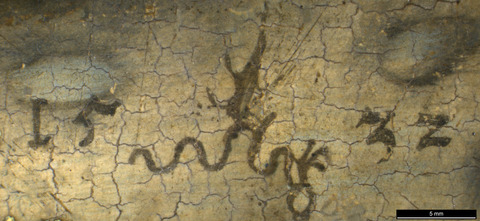
Item 3. Inscription painted in dark gray paint, upper edge above the cross, “INRI” (tech. fig. 3)
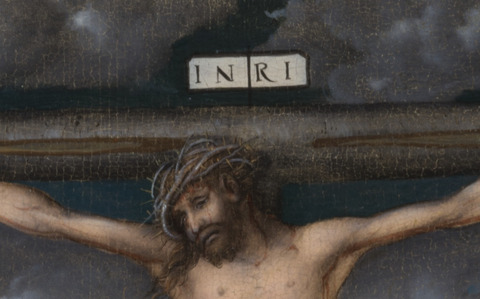
Back:
Item 4. Round stamp, purple ink, upper-left corner, “Zentralstelle für Denkmalschutz * im Bundesm…f. Unterricht” (tech. fig. 4)
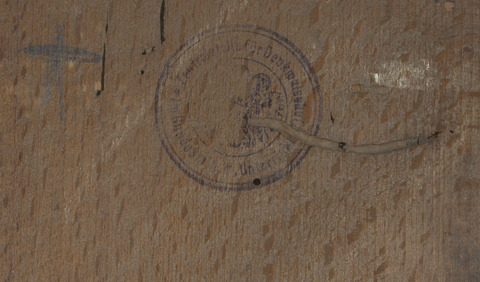
Item 5. Round stamp, purple ink, upper-left corner, “Zentralstaße für Denkmalschutz * im Bundesm…f. Unterricht” (tech. fig. 5)
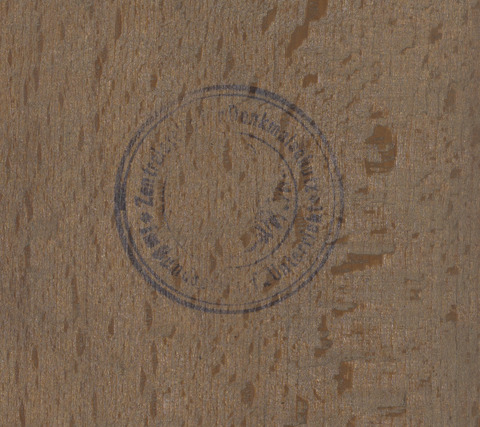
Item 6. Round stamp, black ink, upper-left corner, illegible (tech. fig.6)
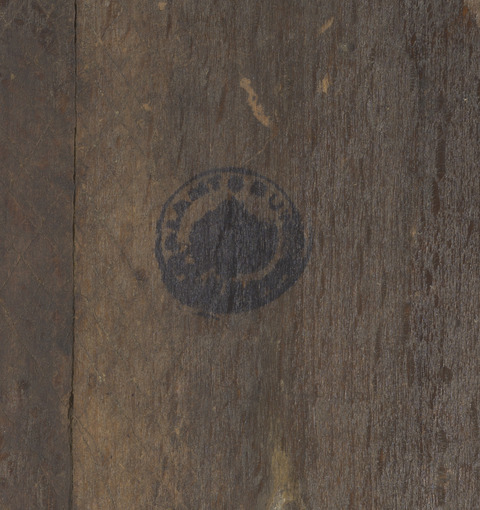
Item 7. Black ink, handwritten, upper-left corner, “N 59” (tech. fig.7)
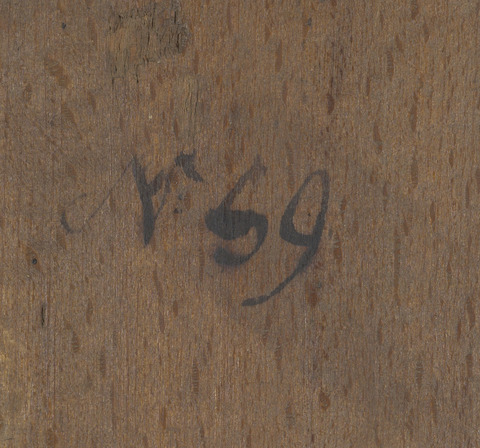
Item 8. Round stamp, purple ink, upper-left corner, “BUNDESDENKMALAMT * WIEN *” (tech. fig.8)
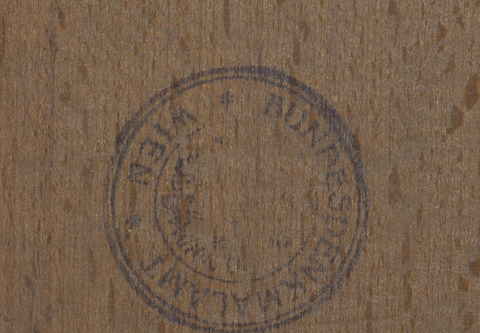
Item 9. Rectangular purple stamp, scratched out in pencil, left side, illegible (tech. fig. 9)
Item 10. Rectangular purple stamp, scratched out in pencil, left side, illegible (tech. fig. 9)
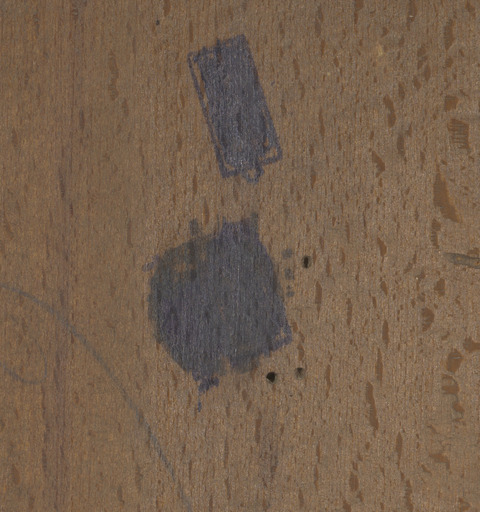
Item 11. Round black stamp with blurred writing, center left side, “…ETTE PA..TICIE.. L… •PARIS•” (tech. fig. 10)
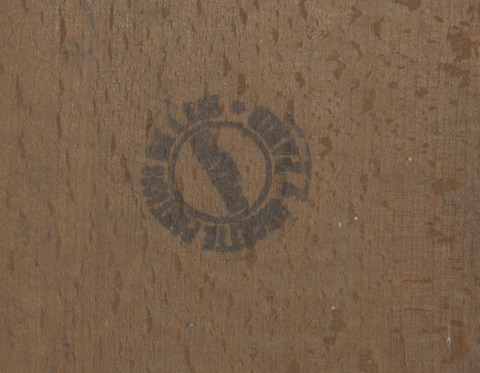
Item 12. Paper label with decorative boarder “Gróf Migazzy Antónia.” (tech. fig. 11)
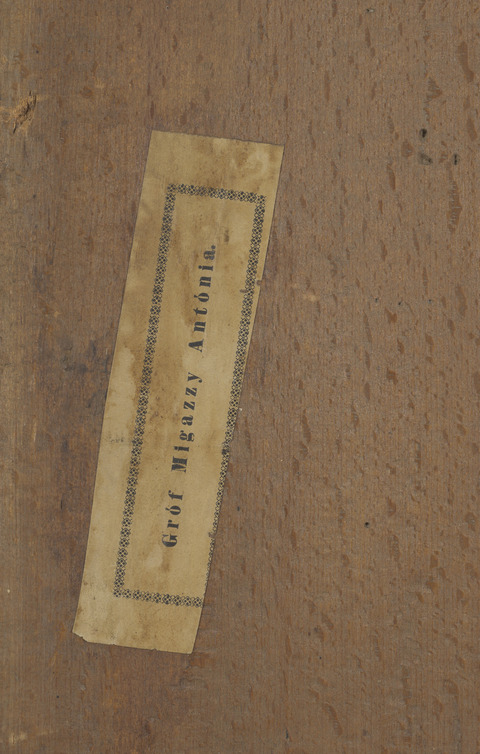
Item 13. Round stamp, purple ink, lower left corner, “POST ZOLLAMT• …N..ONUL” (tech. fig. 12)
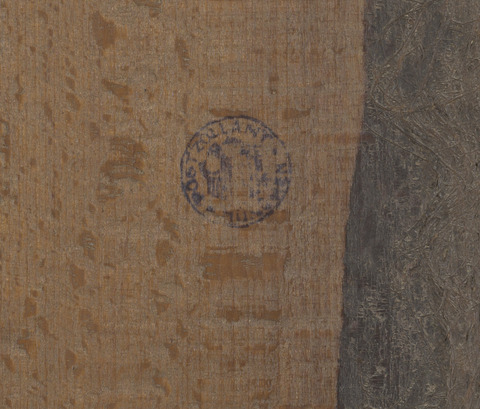
Item 14. Round stamp, purple ink, lower-left corner, illegible (tech. fig.13)
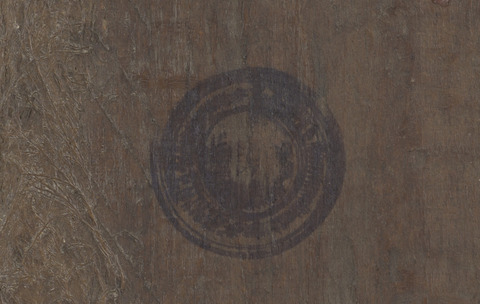
Item 15. Round stamp, black ink, lower-right corner, “PO..T ZOL…CHEN”, mostly illegible (tech. fig.14)
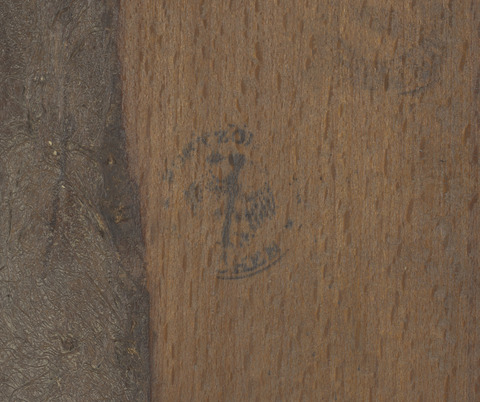
Item 16. Two marks, pencil, upper-right corner, “+ +” (tech. fig.15)
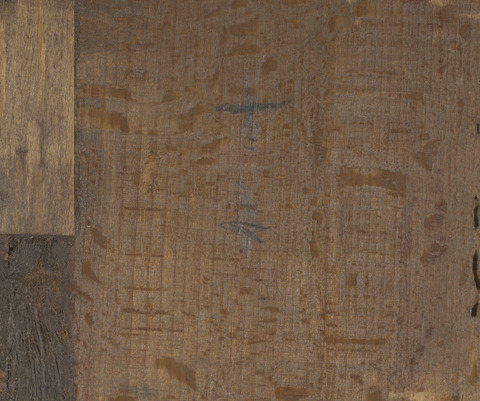
Item 17. Round stamp, faded ink, lower-right corner, illegible (tech. fig. 16)
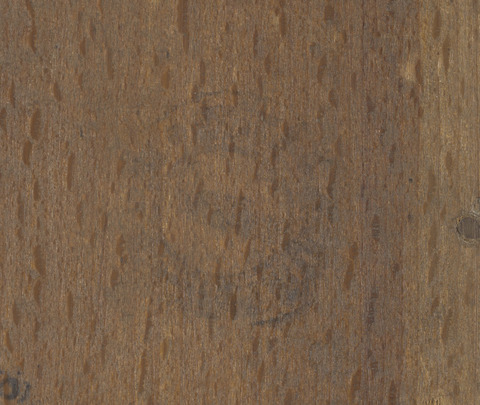
Summary of Treatment History
The painting appears to have had limited structural intervention prior to its arrival at the IMA. Two unoriginal inserts were added to the back to reinforce one of the joins. The painting has been varnished and retouched likely numerous times.
The painting’s condition was checked upon its arrival at the IMA, and paint cleavage along a crack at the bottom-right corner and a small loss at the top-right corner were noted. The cleavage was set down at this time, and losses were inpainted using Paraloid B-72 and dry pigments.1 In July 1980 the painting was assessed by David Miller while it was being studied by a scholar. Miller carried out minimal treatment to consolidate some lifting paint using Paraloid B-72 and adjust pigmented wax fills and inpaint locally with PVA AYAB.2
The painting underwent treatment in 2021 to remove discolored surface coatings, including a polysaccharide gum toning layer and a discolored varnish as well as desaturated inpainting. The painting was varnished with a new, well-saturating surface coating and losses were integrated through inpainting.
The condition of the painting and frame were assessed for the Clowes Collection annual survey from 2011 to 2020.
Current Condition Summary
The painting is in generally good condition for a work of this age. The support is structurally stable and after the 2021 treatment the varnish is clear and the inpainting well matched.
Methods of Examination, Imaging and Analysis
| Examination/Imaging | Analysis (no sample required) | Analysis (sample required) |
|---|---|---|
| Unaided eye | Dendrochronology | Microchemical analysis |
| Optical microscopy | Wood identification | Fiber ID |
| Incident light | Microchemical analysis | Cross-section sampling |
| Raking light | Thread count analysis | Dispersed pigment sample |
| Reflected/specular light | X-ray fluorescence spectroscopy (XRF) | Fourier-transform infrared spectroscopy (FTIR) |
| Transmitted light | Macro X-ray fluorescence scanning (MA-XRF) | Raman microspectroscopy |
| Ultraviolet-induced visible fluorescence (UV) | ||
| Infrared reflectography (IRR) | Gas chromatography–mass spectrometry (GC-MS) | |
| Infrared transmittography (IRT) | Scanning electron microscope -energy dispersive X-ray spectroscopy (SEM-EDS) | |
| Infrared luminescence | Other: | |
| X-radiography |
Technical Examination
Description of Support
Analyzed Observed
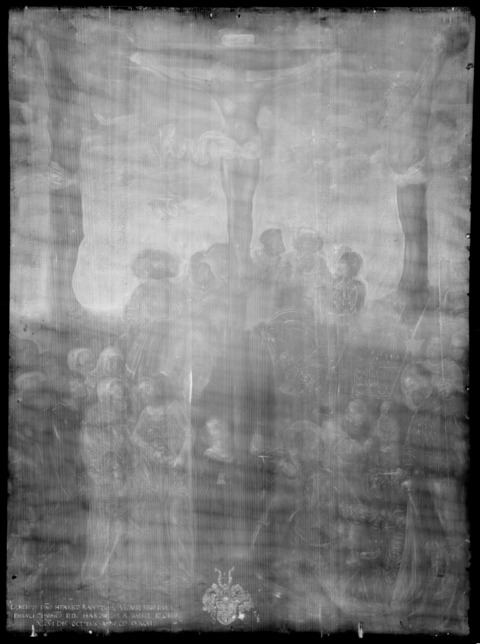
Material Type (fabric, wood, metal, dendrochronology results, fiber ID information, etc.):
The painting is executed on a beech panel support. The use of beech panel is typical of Cranach and his workshop but is rare among other painters of the period.3 The panels were dated using dendrochronology to after 1524, the year the youngest growth ring dates to. Dendrochronologist Peter Klein surmised the earliest possible date for the painting would be 1526 when 2 years for seasoning and creation are added to the earliest felling date. 4 This date range aligns with the 1532 date on the panel.
Characteristics of Construction/Fabrication (cusping, beveled edges of panels, seams or joins, battens):
The panel is composed of three vertical planks that have been butt-joined. The first plank (left to right when viewed from the back) is 17.8 cm, the central plank is 26.5 cm wide, and the right plank is 12 cm wide. The ring pattern on the edge of the boards suggests that they were radially sawn. Notably, Peter Klein and the Cranach Digital Archive have identified more than 20 other works by Cranach with supports made from the same tree.5
The panel has been thinned slightly on the edges but has not been thinned in the center. Original tooling marks are visible on the back of the panel in this area. This is particularly pronounced in raking light (tech. fig. 18).
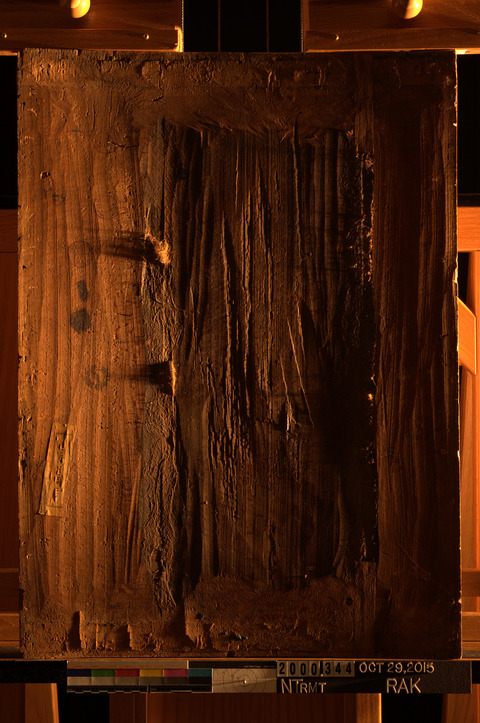
Along the joins on the back of the support, adhesive with what appears to be hair or fibers has been applied for reinforcement (tech. fig. 19, 20). This material, referred to as tow, is widely found on Cranach panels from after 1514.6
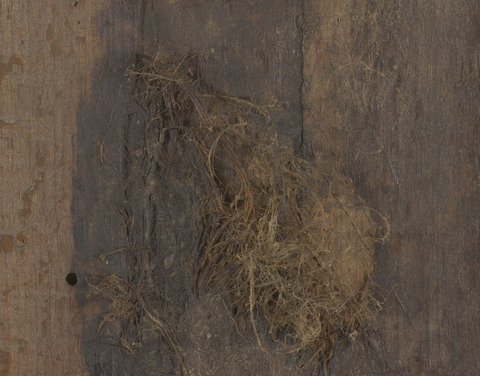
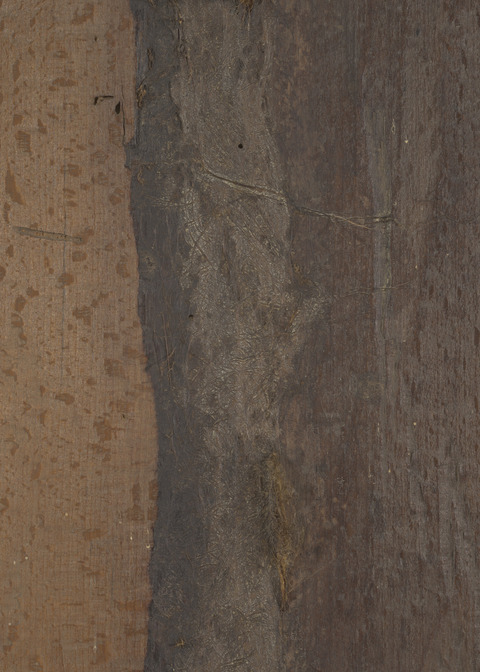
Two reinforcements that are not original to the construction are present along the right panel join at the top and bottom of the panel. The top reinforcement measures 12.5 cm × 2.5 cm. The bottom reinforcement measures 12 cm × 2.5 cm.
Thickness (for panels or boards):
5 mm thick
Production/Dealer’s marks:
None
Auxiliary Support:
Original Not original Not able to discern None
Condition of Support
The support is in excellent condition for a work of this age. The support does not appear to have been thinned or altered in any significant way. There are several hairline cracks along the grain of the bottom edge. The crack in the left plank is 4.5 cm long. The crack in the center plank is 4 cm long. The crack in the right plank 7.8 cm long. All the cracks appear stable and have not affected the paint layer in any significant way. The planks have assumed a gentle convex curvature that is natural for an uncradled panel (tech. fig. 21). The joins are stable and nearly invisible in the paint layer.

Description of Ground
Analyzed Observed
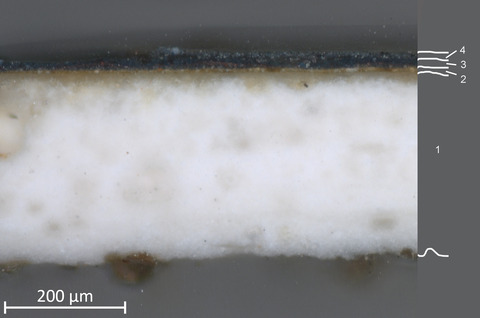
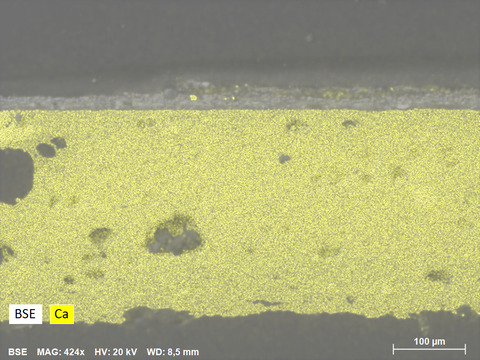
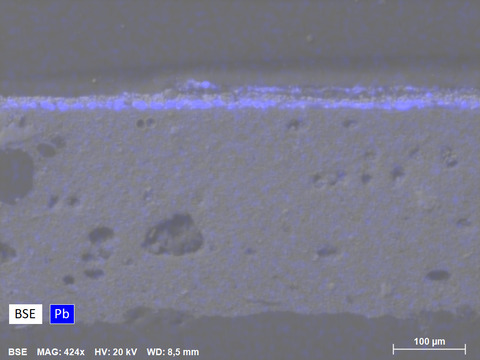
Materials/Binding Medium:
The ground is composed of a thick layer of calcium carbonate (chalk) (tech. fig. 22, layer 1, and tech. fig. 23), which is uniform in its composition. Small coccoliths are visible in the SEM image along the upper edge of the ground (tech. fig. 25). The presence of coccoliths, indicating the use of sedimentary chalk, has only been found on one other Cranach painting according to a comprehensive study by conservator Gunnar Heydenreich. Most Cranach paintings analyzed were found to more likely be composed of finely grained calicum carbonate from local limestone, although there is no indication that Cranach intentionally diferentiated his sources of chalk. 7
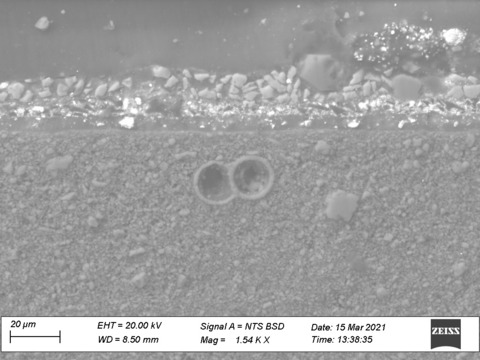
A very thin lead-containing imprimatura was applied over the ground layer, likely to seal the oil-absorbent chalk ground (tech. fig. 24).8 Of the works identified as having supports constructed from the same tree, two have had their ground layers analyzed. These works, Cardinal Albrecht of Brandenburg, Prince of Mainz (1490–1545) as St Jerome and Lucretia, date to 1527 and 1530 respectively, and both have grounds composed of chalk with a thin lead white imprimatura.9
Color:
The ground and imprimatura are off-white in color. This is commonly found in Cranach paintings, although he also sometimes used a tinted imprimatura.10
Application:
The thick chalk ground was likely applied with a brush and later smoothed flat. No evidence of textured brush strokes can be found in the X-radiograph, as is sometimes the case on Cranach’s paintings.11 Similarly smooth preparations can be seen in the X-radiographs of Margrave Casimir of Brandenburg-Kulmbach (after 1524), Johann the Steadfast, Elector of Saxony (about 1526), Lucretia (1530), and Apollo and Diana (1530), all of which have the same style of signature and whose supports have been identified as coming from the same tree as the Clowes painting.12
Thickness:
The chalk ground is approximately 250 µm and the lead-containing imprimatura is approximately 10 µm.
Sizing:
The panel is likely to have been sized before the application of the ground layers. However, no evidence of a sizing layer was found on the cross-section samples.
Condition of Ground
The ground is in excellent condition. There is a network of craquelure that is consistent with the age of the painting. There are several small losses to the ground at the edges of the painting.
Description of Composition Planning
Methods of Analysis:
Surface observation (unaided or with magnification)
Infrared reflectography (IRR)
X-radiography
Analysis Parameters:
| X-Ray equipment | GE Inspection Technologies Type: ERESCO 200MFR 3.1, Tube S/N: MIR 201E 58-2812, EN 12543: 1.0mm, Filter: 0.8mm Be + 2mm Al |
|---|---|
| KV: | 22 |
| mA: | 3.0 |
| Exposure time (s) | 120 |
| Distance from x-ray tube: | 36” |
| IRR equipment and wavelength | Opus Instruments Osiris A1 infrared camera with InGaAs array detector operating at a wavelength of 0.9-1.7µm. |
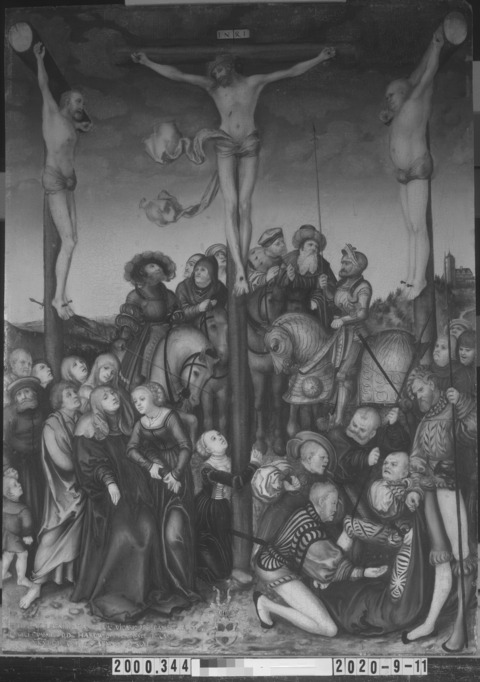
Medium/Technique:
Despite the careful planning of the elaborate composition, there is no evidence of underdrawing visible using infrared reflectography. This is not unique in the Cranach oeuvre, where, in some cases, underdrawing has not been detected.13 However, underdrawing is often visible, most frequently applied using black pigment in a liquid medium with a pointed brush.14 The absence of underdrawing in IRR may suggest the use of red chalk, which has been found on several works by Cranach.15
Description of Paint
Analyzed Observed
Application and Technique:
The painting technique is a masterful combination of seamless blending of color and a graphic quality created by extensive outlining. In the initial stages of painting, the artist masterfully manipulated the oil medium to seamlessly blend color to create form. The final stages included the application of minute graphic details that create an absorbing composition with a graphic quality that is typical of Cranach’s production.
The careful blending and crisp edges of this complex composition make it difficult to determine the exact order in which the composition was created. Close examination reveals little overlap between areas of color, which is further illustrated in the MA-XRF maps (tech. figs. 35–42). This precision suggests that the composition was carefully laid out before the painting stage, and once painting commenced, blocks of color were applied to each respective area. For instance, technical figure 27 shows the area where Mary’s white veil meets her blue cloak. A sliver of ground is visible between these areas of color indicating that the blue was applied first up to a predetermined edge. The white of the veil was then subsequently applied.
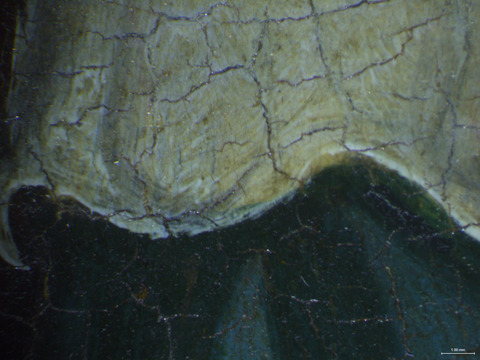
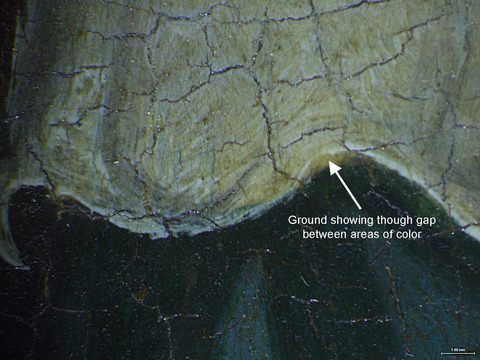
Once the general composition was established, the form in each area of color was built up through the application of highlights and shadows that were then blended with the midtone. The artist exploited the slow drying time of oil and its ability to create seamless transitions of form through blending. Each area of color uses a different combination of highlights and shadows to create form. Folds of the blue drapery are articulated using this wet-in-wet technique with white highlights blending seamlessly into dark blue shadows. In the orange sleeves of the figures, lead-tin yellow highlights are applied over orange midtones and dark brown shadows to create form. In area of white, black is mixed in to create gray midtones and shadows.
Unsurprisingly, the complex grouping of figures appears to have been painted, or at least blocked in, before the application of the sky. Technical figure 28 shows pink sky paint applied around the soldier’s helmet, some of which extends over the helmet.
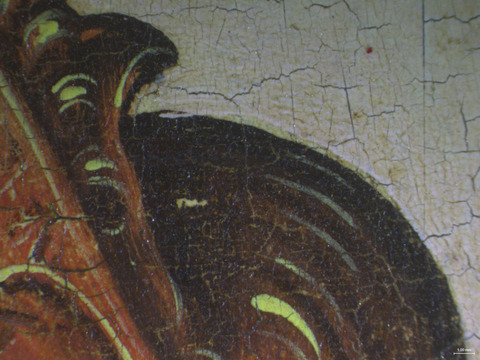
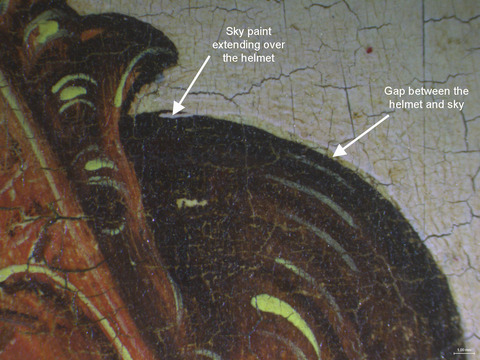
Several details do appear to have been left out of the original compositional design, or perhaps were intended to be painted over the established composition. These include a staff that is held by a man on the right side of the panel. The paint of the staff extends over an area of drapery and was established using incision lines into the painted drapery (tech. fig. 29).
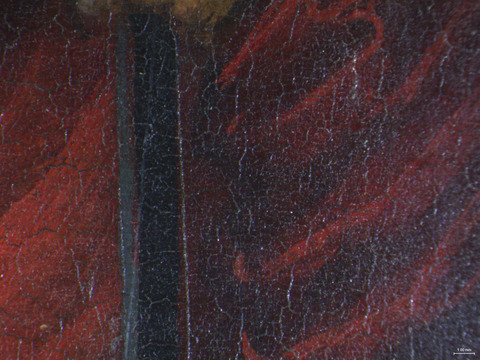
The faces are painted using a subtle application of glazes over midtones and highlights. A light pink is used as the base tone for the female figures, while the male figures have ruddier complexions. Masterful blending of color is used in these areas as well.
The final stage of painting involved the application of extensive detailing. This stage creates the signature graphic appearance of Cranach’s painting. Detailing in black, brown, yellow, and white articulates individual eyelashes, fingernails, and strands of hair (tech. figs. 31-34). Decorative detailing on the clothes and armor (tech. fig. 32) create the luxury fabrics worn by each figure. Delicately rendered streaks of red blood were applied to the face and body of Christ (tech. fig. 30).
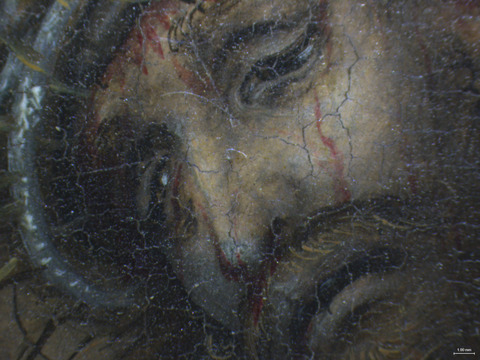
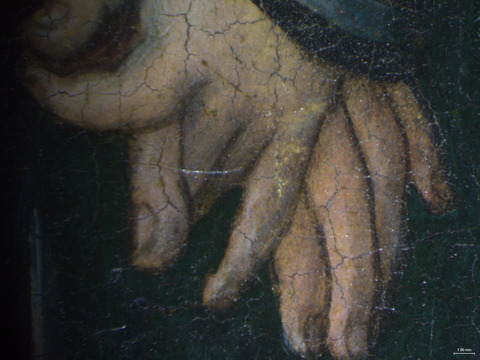
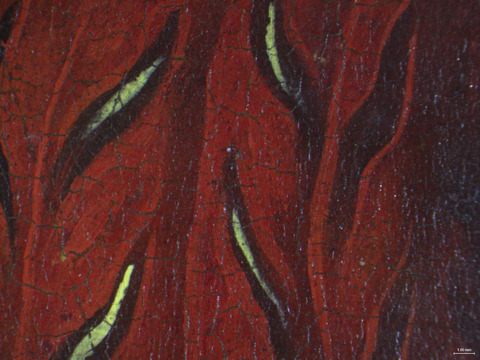
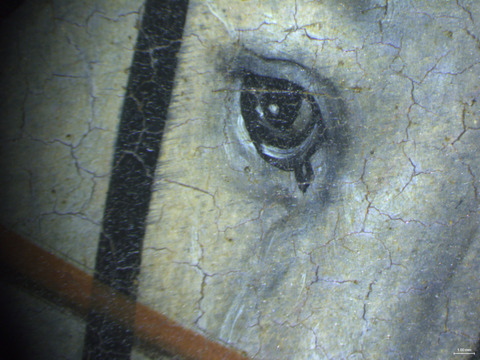
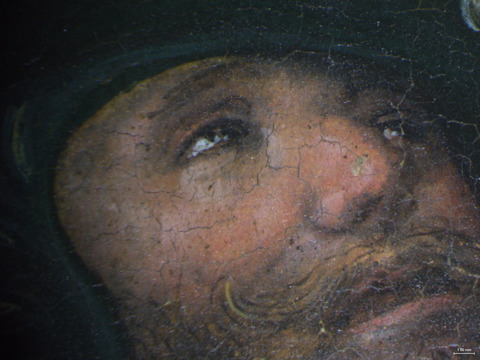
Painting Tools:
The paint is applied using a range of small brushes.
Binding Media:
The binding media is almost certainly oil, although this has not been tested.
XRF Analysis and Color Palette:
The color palette is vibrant and wide ranging, including passages of blue, green, red, orange, brown, yellow, white, and gray. MA-XRF analysis detected a limited range of pigments that are typical of this period of painting and of Cranach’s studio (tech. fig. tech. figs. 35-42).
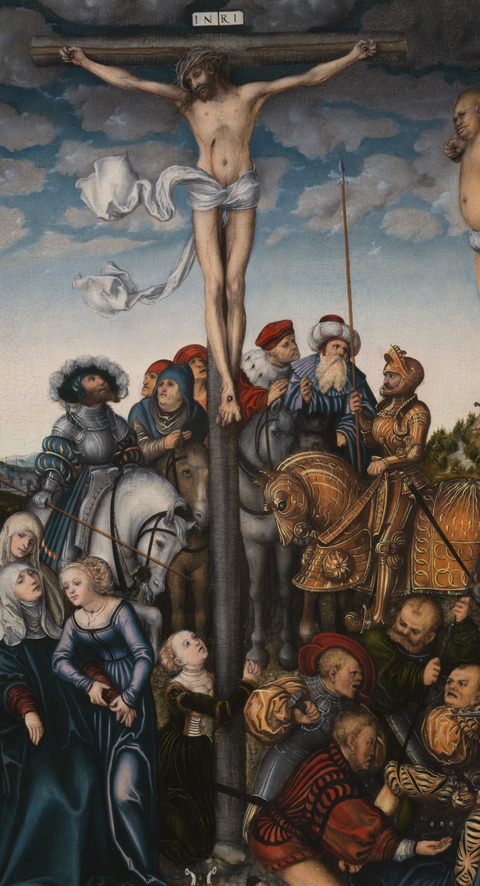
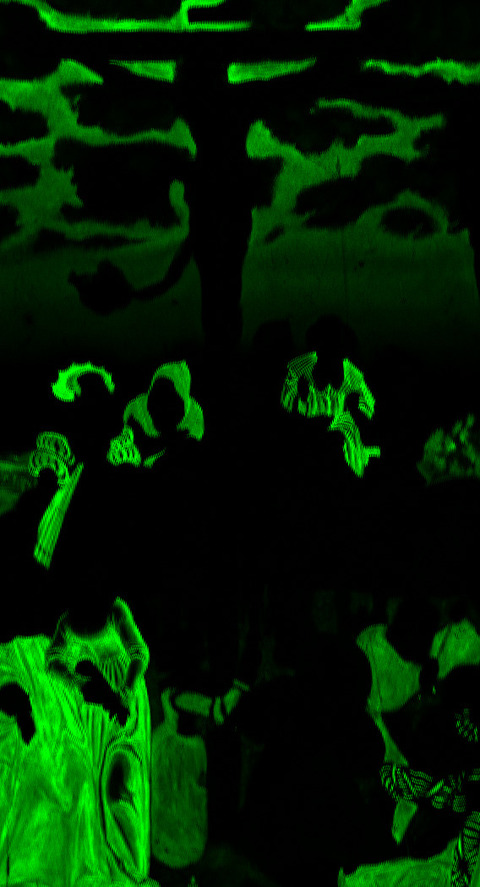
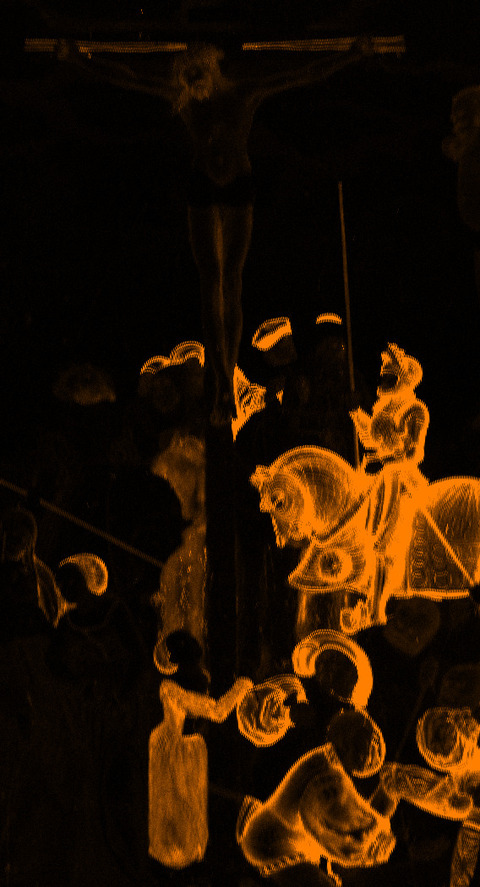
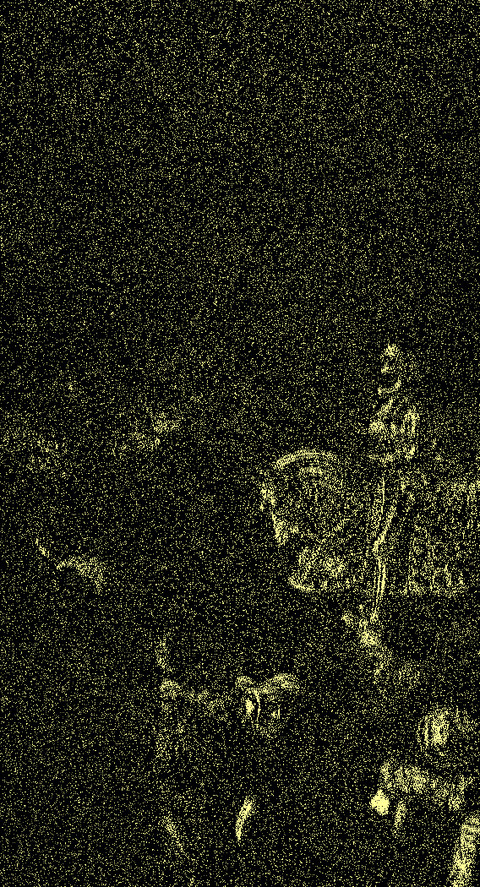
Strong peaks for copper were detected in all areas of blue paint suggesting the widespread use of azurite in the painting. Although Cranach occasionally used other blue pigments, it is common for azurite to be the only blue used in Cranach paintings.16 There is a clear presence of copper in the sky as well as in the blue and green areas of drapery. Azurite was identified in the sky of other Cranach paintings including Cardinal Albrecht of Brandenburg, Prince of Mainz (1490–1545) as St. Jerome.17 Although there are fewer passages of green on this painting than many Cranach works, MA-XRF analysis of the foliage and green drapery yielded strong peaks of copper. This suggests the use of verdigris and/or copper-containing green glazes in these areas (tech. fig. 36).
Lead was detected widely suggesting the extensive use of lead white both in the imprimatura layer (see Description of Ground) and in the paint layer. Lead-tin yellow as well as yellow ocher appear to have been used in the painting. Tin was detected in the bright yellow detailing on the armored horse (tech. fig. 38) as well as in the inscription and in highlights of a man’s green sleeve (tech. fig. 42).
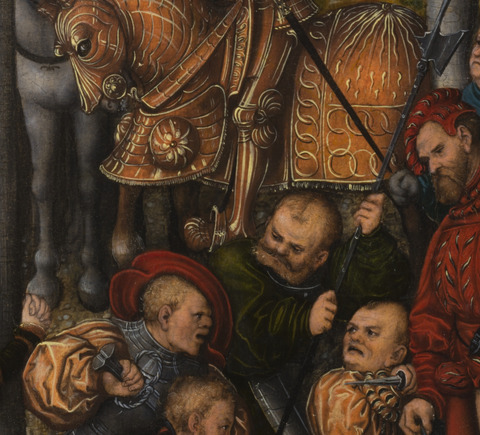
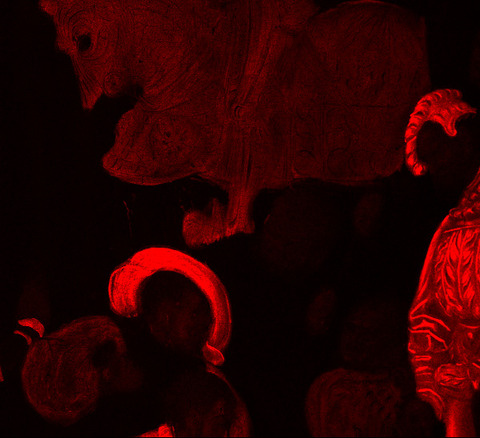
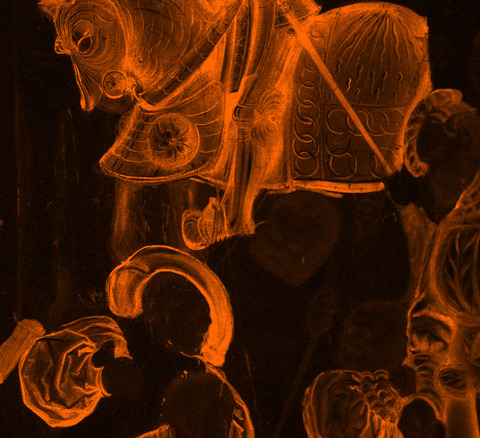
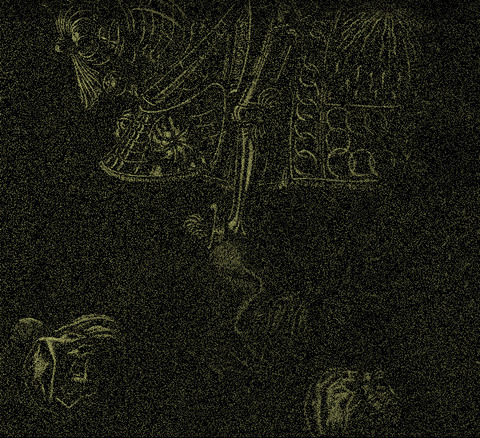
The bright orange armor for the horse is remarkable in its vibrancy. Iron and mercury were detected in these areas area suggesting a mixture of vermilion and yellow ocher was used. No tin was detected in the deep orange, suggesting the use of lead-tin yellow was reserved for the detailing on the armor.
Analysis of a similar vibrant brown passage from Altarpiece of the Holy Kinship by the artist detected a brown organic colorant that could not be identified.18 It is possible that a similar colorant is used here, but this has not been confirmed through analysis.
Mercury was also detected in passages of red (tech. fig. 40), such as the figures' hats and red clothing, suggesting the use of vermilion in these areas. Cross section 2 from an area of dark red shadows shows a layer of red (layer 4) associated with potassium and aluminum (tech. fig. 43, light purple) over copper-containing blue paint (tech. fig. 44, green) and the calcium carbonate ground. The presence of aluminum in an area of dark red without iron or mercury suggests the use of a red lake pigment with an alum substrate.
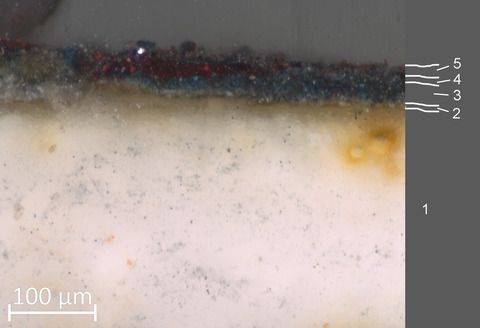
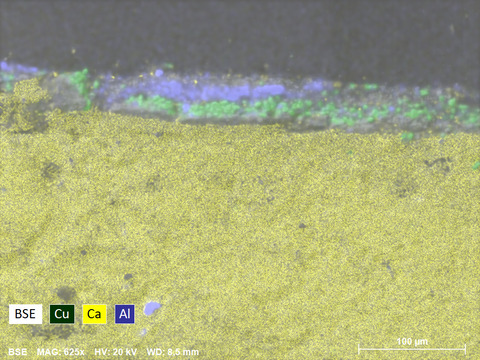
Surface Appearance:
The surface is generally smooth with little texture from the paint application. This is likely due to smoothing of the ground layer during the preparation of the panel.
Condition of Paint
The condition of the paint is generally good. There are a few small losses scattered across the surface of the painting and along the edge of the panel. There are also some areas of slight abrasion. Minimal paint loss along the hairline cracks at the top and bottom of the painting is also present. This is most severe along the crack that runs through Mary’s dress. The most severe damages to the paint layer are several long, deep scratches, present on both sides of the sky and in the lower-right section of the painting.
Description of Varnish/Surface Coating
Analyzed Observed Documented
| Type of Varnish | Application |
|---|---|
| Natural resin | Spray applied |
| Synthetic resin/other | Brush applied |
| Multiple Layers observed | Undetermined |
| No coating detected |
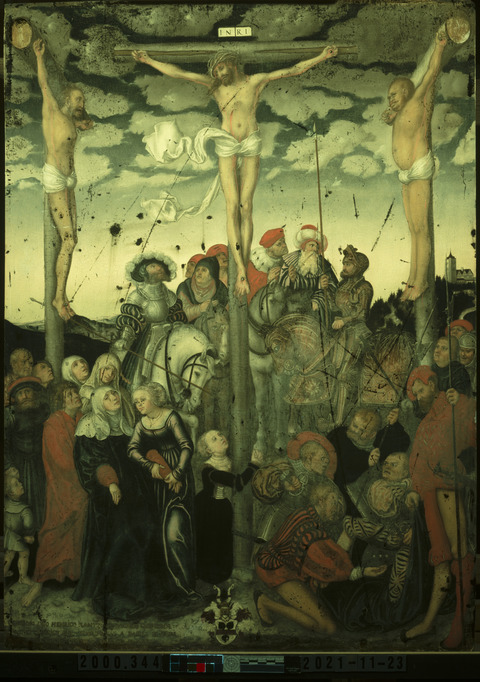
During the 2021 treatment, layers of natural resin varnish and watercolor toning were removed. A condition report from 1980 noted that the varnish appeared to be somewhat soluble in saliva, which was confirmed in 2021.19 However, FTIR analysis identified this coating as a polysaccharide gum, suggesting that it had been applied as yellow toning layer, particularly in the bright white sky. When these layers were removed, the sky was well preserved and intact, indicating the yellow toning was applied as a matter of taste to give the painting an aged patina over what would have been a clear natural resin varnish when the painting was last treated (tech. fig. 46).
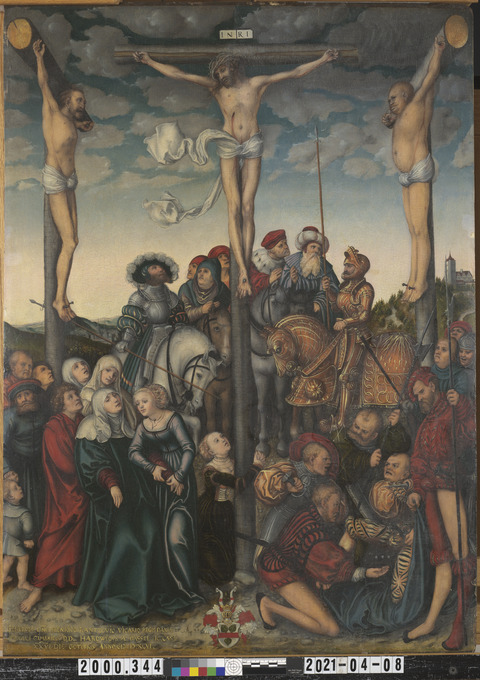
As part of the 2021 treatment, a synthetic resin varnish of 30% Laropal A81 in Shellsol A100 was brush applied to the surface. Fills and inpainting were applied to the areas of minor loss, and the scratches and losses were inpainted using Gamblin Conservation Colors in Laropal A81. A final spray varnish composed of 20% Laropal A81 in Shellsol A100 was then applied.
Condition of Varnish/Surface Coating
After the 2021 treatment, the varnish is clear and well-saturating, and the inpainting is well matched.
Description of Frame
Original/first frame
Period frame
Authenticity cannot be determined at this time/ further art historical research necessary
Reproduction frame (fabricated in the style of)
Replica frame (copy of an existing period frame)
Modern frame

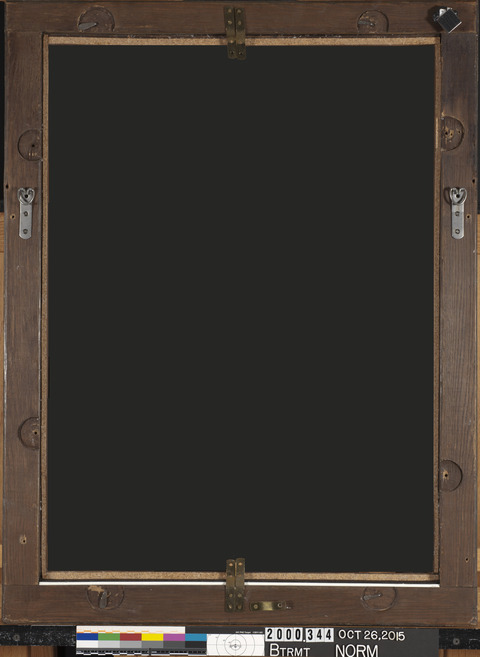
Frame Dimensions:
Outside frame dimensions: 86.6 cm × 65.7 cm × 5.4 cm
Sight size: 73.5 cm × 54 cm
Distinguishing Marks:
None
Description of Molding/Profile:
The frame is a cassetta-style frame composed of four pieces of carved wood with mitered corners. The right, left, and top members have the same molding pattern with the flat sections of molding painted in a matte black paint. The bottom edge has a less intricate molding pattern and a decorative painted boarder. The frame has been backed with four pieces of butt-joined wood. The carved wood is covered with a thin white ground layer and a red bole. Water gilding has been applied across the surface.
Condition of Frame
The frame is in good condition. There is a pattern of age cracks in the gilding but there is no sign of lifting or flaking
Additional Comments
A wood build out was applied to the back of the frame in 2022 to accommodate the addition of glazing.
Notes
-
Condition assessment, before Oct 1973 (undated), Collection Clowes, Clowes Registration Archive, Indianapolis Museum of Art at Newfields. ↩︎
-
David Miller, condition assessment, C10030 (2000.344), 3 July 1980, Conservation Department Files, Indianapolis Museum of Art at Newfields. ↩︎
-
Gunnar Heydenreich, Lucas Cranach the Elder: Painting Materials, Techniques and Workshop Practice (Amsterdam: Amsterdam University Press, 2007), 48-49. ↩︎
-
Peter Klein, dendrochronological analysis report, C10030 (2000.344), 20 April 1999, Conservation Department Files, Indianapolis Museum of Art at Newfields. ↩︎
-
For a list and images of the other works found to be from this support see Cranach Digital Archive, painting number US_IMA_2000-344. https://lucascranach.org/US_IMA_2000-344 ↩︎
-
Gunnar Heydenreich, Lucas Cranach the Elder: Painting Materials, Techniques and Workshop Practice (Amsterdam: Amsterdam University Press, 2007), 70–73. ↩︎
-
Gunnar Heydenreich, Lucas Cranach the Elder: Painting Materials, Techniques and Workshop Practice (Amsterdam: Amsterdam University Press, 2007), 93. ↩︎
-
Gunnar Heydenreich, Lucas Cranach the Elder: Painting Materials, Techniques and Workshop Practice (Amsterdam: Amsterdam University Press, 2007), 98. ↩︎
-
Lucretia, Finnish National Gallery, Helsinki, Cranach Digital Archive, CDA ID/ inventory number FIN_FNG_S-1994-224: https://www.lucascranach.org/FIN_FNG_S-1994-224. Cardinal Albrecht of Brandenburg, Prince of Mainz (1490–1545) as St Jerome, Staatliche Museen zu Berlin, Gemäldegalerie, Cranach Digital Archive, CDA ID/ inventory number DE_smbGG_589: https://www.lucascranach.org/DE_smbGG_589. ↩︎
-
Gunnar Heydenreich, Lucas Cranach the Elder: Painting Materials, Techniques and Workshop Practice (Amsterdam: Amsterdam University Press, 2007), 93–104. ↩︎
-
Gunnar Heydenreich, Lucas Cranach the Elder: Painting Materials, Techniques and Workshop Practice (Amsterdam: Amsterdam University Press, 2007), 99–100. ↩︎
-
Margrave Casimir of Brandenburg-Kulmbach, Vienna, Kunsthistorisches Museum, Cranach Digital Archive, CDA ID/ inventory number AT_KHM_GG883: https://www.lucascranach.org/AT_KHM_GG883. Johann the Steadfast, Elector of Saxony, Klassik Stiftung Weimar, Museums, Cranach Digital Archive. Inventory DE_KSW_G6: https://lucascranach.org/DE_KSW_G6. Lucretia, Helsinki, Finnish National Gallery, Cranach Digital Archive, CDA ID/ inventory number FIN_FNG_S-1994-224: https://www.lucascranach.org/FIN_FNG_S-1994-224. Apollo and Diana, Staatliche Museen zu Berlin, Gemäldegalerie, Cranach Digital Archive, CDA ID/ inventory number DE_smbGG_564: https://www.lucascranach.org/DE_smbGG_564. ↩︎
-
Gunnar Heydenreich, Lucas Cranach the Elder: Painting Materials, Techniques and Workshop Practice (Amsterdam: Amsterdam University Press, 2007), 107. ↩︎
-
Gunnar Heydenreich, Lucas Cranach the Elder: Painting Materials, Techniques and Workshop Practice (Amsterdam: Amsterdam University Press, 2007), 105. ↩︎
-
Gunnar Heydenreich, Lucas Cranach the Elder: Painting Materials, Techniques and Workshop Practice (Amsterdam: Amsterdam University Press, 2007), 106. ↩︎
-
Gunnar Heydenreich, Lucas Cranach the Elder: Painting Materials, Techniques and Workshop Practice (Amsterdam: Amsterdam University Press, 2007), 154. ↩︎
-
Cardinal Albrecht of Brandenburg, Prince of Mainz (1490–1545) as St Jerome, Staatliche Museen zu Berlin, Gemäldegalerie, Cranach Digital Archive, CDA ID/ inventory number DE_smbGG_589 https://www.lucascranach.org/DE_smbGG_589 ↩︎
-
Gunnar Heydenreich, Lucas Cranach the Elder: Painting Materials, Techniques and Workshop Practice (Amsterdam: Amsterdam University Press, 2007), 159. ↩︎
-
David Miller, condition assessment, C10030 (2000.344), 3 July 1980, Conservation Department Files, Indianapolis Museum of Art at Newfields. ↩︎
Additional Images
